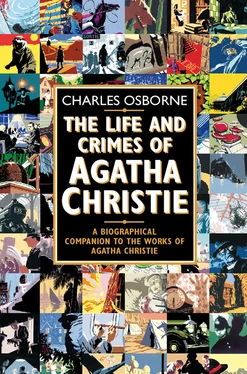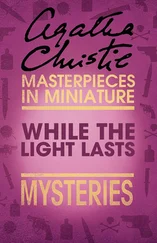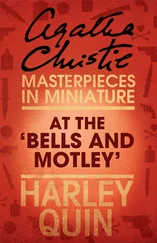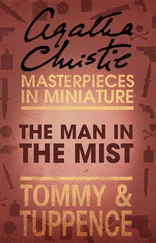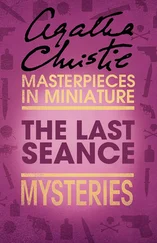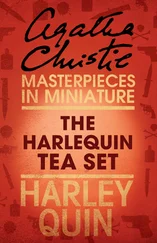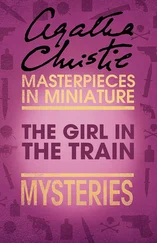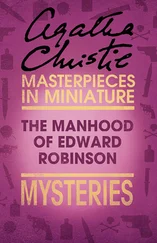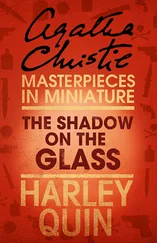Years earlier, Agatha and her sister Madge had one day been discussing a murder mystery they were reading, and Agatha had mentioned, idly, that she would like to try her hand at a detective story. Madge was of the opinion that Agatha would find this too difficult a task, an opinion which Agatha remembered in 1916, while working in the hospital dispensary at Torquay. She decided to devote her occasional slack periods at the dispensary to the composition of a detective novel, in the hope of proving her sister wrong.
Her first problem, as Agatha Christie revealed many years later in her autobiography, was to decide what kind of detective story she would write. Since she was surrounded by poisons, it was natural that death by poisoning should be the method she selected. She settled on one particular fact or donné which seemed to her to have possibilities, toyed with the idea for a time, and finally decided upon it. Next she turned to the dramatis personae. Who should be poisoned? Who would be the poisoner? When? Where? How? Why? It would, she decided, have to be ‘very much of an intime murder’, because of the method chosen. It would have to be all in the family, so to speak.
And, of course, there would have to be a detective to unravel the mystery and unmask the evil-doer. An avid reader of the Sherlock Holmes stories of Sir Arthur Conan Doyle, Agatha pondered upon the personality and methods of Holmes and his relationship with Dr Watson, his friend and the chronicler of his cases. Her detective, she decided, would have to be as different in personality from Sherlock Holmes as possible. However, the device of the friend and helper, the Dr Watson-figure whose obtuseness sets off the brilliant deductive powers of the great detective, was too useful to discard. Her detective would, therefore, have such a figure in attendance, and he could be the narrator of the story. The budding crime writer now had an idea for the actual crime, and a detective and his aide. But who were the other characters to be? Who was to be murdered? Husbands frequently murdered their wives, of course, but perhaps it would be better to opt for a more unusual kind of murder and for a very unusual motive. But then the whole point of a really good murder mystery was that the criminal should be someone obvious, whose obviousness was not apparent until pointed out in the last chapter by the brilliant detective. At this point in her reasoning, Agatha Christie confessed later, she became confused and went away to make up a couple of extra bottles of hypo-chlorous lotion, so that she would have more free time the following day to give further consideration to her crime project.
Over the next few days, her plot began to develop in some detail, though in a somewhat unorthodox manner. Having first decided what she wanted her murderer to look like, Agatha next began to search around among her acquaintances for someone who fitted the description, in order to study his physical characteristics. She soon realized, however, that it was pointless to attempt to base a fictional character upon a real person’s characteristics. Later, with experience, she would find ways of doing this to some extent, but for the present she was in need of a starting-off point. She found it when, sitting in a tram, she saw exactly what she wanted: ‘a man with a black beard, sitting next to an elderly lady who was chattering like a magpie.’ As she did not know these people, her imagination was unfettered; she could invent characters for them, and place them in situations of her own invention.
She continued to give consideration to the question of the detective. It was important that he should not be simply an imitation Sherlock Holmes. What other models were there? Arsène Lupin? The young journalist Rouletabille in The Mystery of the Yellow Room? 1 Конец ознакомительного фрагмента. Текст предоставлен ООО «ЛитРес». Прочитайте эту книгу целиком, купив полную легальную версию на ЛитРес. Безопасно оплатить книгу можно банковской картой Visa, MasterCard, Maestro, со счета мобильного телефона, с платежного терминала, в салоне МТС или Связной, через PayPal, WebMoney, Яндекс.Деньги, QIWI Кошелек, бонусными картами или другим удобным Вам способом.
Perhaps the detective could be a scientist. Or a schoolboy? A schoolboy would be too difficult, and Agatha was not acquainted with any scientists. Then she remembered the colony of Belgian war refugees who were living in the parish of Tor, in Torquay. Might not one of them be a Belgian police officer? A retired Belgian police officer, not too young:
I allowed him slowly to grow into his part. He should have been an inspector, so that he would have a certain knowledge of crime. He would be meticulous, very tidy, I thought to myself, as I cleared away a good many untidy odds and ends in my own bedroom. A tidy little man. I could see him as a tidy little man, always arranging things, liking things in pairs, liking things square instead of round. And he should be very brainy – he should have little grey cells of the mind – that was a good phrase: I must remember that – yes, he would have little grey cells. He would have rather a grand name – one of those names that Sherlock Holmes and his family had. Who was it his brother had been? Mycroft Holmes. 2 Конец ознакомительного фрагмента. Текст предоставлен ООО «ЛитРес». Прочитайте эту книгу целиком, купив полную легальную версию на ЛитРес. Безопасно оплатить книгу можно банковской картой Visa, MasterCard, Maestro, со счета мобильного телефона, с платежного терминала, в салоне МТС или Связной, через PayPal, WebMoney, Яндекс.Деньги, QIWI Кошелек, бонусными картами или другим удобным Вам способом.
Since he was to be a little man, it seemed an amusing idea to name the retired detective Hercules, the hero of Greek myth. Where did ‘Poirot’ come from? Did Agatha Christie think of her little detective as also being pear (poire)-shaped? Later, she was unable to remember. But she liked the sound of ‘Hercule Poirot’, and enthusiastically set to work on the other characters and on the plot, inventing situations, revelations and false clues during her leisure time at the dispensary and at home. Eventually, she began to write her novel, using a battered old typewriter that had belonged to her sister. Her method was to produce a first draft of each chapter in longhand and then revise the chapter as she typed it.
About halfway through, Agatha began to find herself in difficulties with her complicated plot, at which point her mother suggested that, if she was ever going to bring her novel to a successful conclusion, she should take the typescript away with her on her holiday from the hospital, and work at it with nothing else to distract her. And so, in the summer of 1916, Mrs Archibald Christie took herself off to beautiful, grey, remote Dartmoor, quite near Torquay in distance, but a world away in atmosphere with its rugged moorland, giant granite tors on craggy hills, ancient stone circles, and prehistoric remains.
Much of the 365 square miles of Dartmoor is bleak country, with treacherous bogs. But a few hundred yards from the summit of Hay Tor, the Moorland Hotel is situated, partially hidden by trees, with views over the moor and across south Devon to the sea, and it was there that Agatha Christie lived for two weeks while she finished writing the murder mystery which she had decided to call The Mysterious Affair at Styles. The hotel is still there, though it has been closed since fire destroyed some of its rooms in March 1970. Years later, Agatha Christie described her two weeks’ stay at the Moorland Hotel in 1916:
Читать дальше
